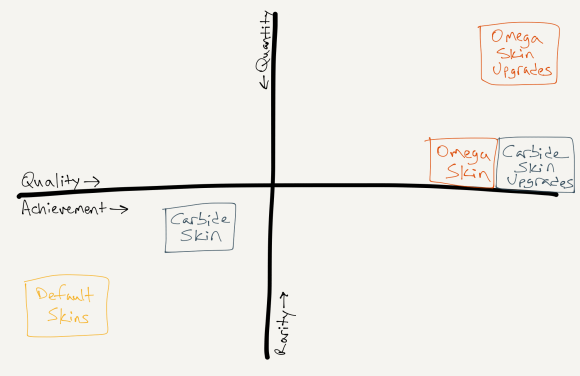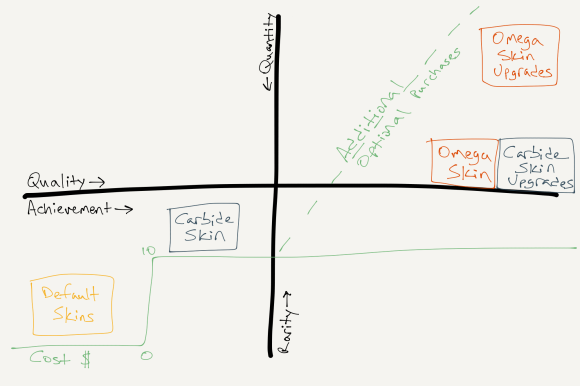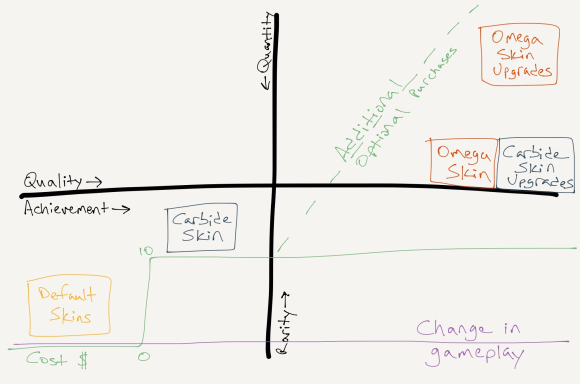Fortnite is all the rage right now. It came out a little less than a year ago considered nothing more than a free PlayerUnknown’s Battlegrounds (PUBG) knockoff, but in that time, Fortnite has come to dominate the gaming industry. Some background for the non-gamer types, Fortnite is a free to play video game which means a majority of the game is available to play at no cost. There are many variations on free to play business model, but for Fortnite, the full gameplay functionality is available to everyone. There is one map and one game mode that all people play no matter what you’ve paid for the game. While you don’t need to pay money to play, costumes and skins for your character are available for purchase. These features aren’t too intriguing on their own, but when combined with a uniquely designed quarterly season pass, called the Battle Pass, the package becomes a multi–million dollar a day phenomenon.
BATTLE PASS
The Battle Pass is a $10 opt in quarterly subscription that is tied to “seasons” in the game. Every three-ish months Fortnite gets a huge update that comes with changes to the map, different character skins, and a new Battle Pass. While everyone is still playing the same underlying game, the pass unlocks new challenges and a leveling system with rewards that adds a reason to keep playing Fortnite. On top of that, everyone’s level resets at the start a new season, so it’s a chance to rank up again to collect all the new items, emotes and experience points. It’s amazing this setup makes any money at all because there is still no need to purchase anything to play the game the exact same way with everyone else. Everything you can purchase is purely for looks**.
Once players buy in to the Battle Pass they are more inclined to continue paying because the game loses some of its intrigue without the content unlocked from the pass. Fortnite reverts to a singular leveling system without much of a goal to the game other than to keep winning and just have fun. You can keep playing on the free tier, but for many (which is quite a lot of people judging by the sales figures) the point of the game is to unlock more content for your character. And what’s the way to do it? Keep playing the game. Keep buying the Battle Pass.
Aside from the joy of almost winning, there is not as much feeling of accomplishment in the free tier. Yet the paid tier continues to be fun because there are just more things to do, even if all sense of additional achievement is fake (not sure what that says about playing video games in general). But the irony is all players are still playing the same base game whether they are paying or not. The progression is purely superficial.
RARITY VS ACHIEVEMENT
And quantity vs quality
The Fortnite development studio, Epic Games, understands their position of reliance on in game purchases, and the Battle Pass for the new Season 4 doubles down on the business strategy. The same leveling and unlockable content system continues to exists from previous seasons, but now there are two skins (Carbide and Omega) than can be upgraded by playing the game more. With the introduction of these upgradeable skins, Epic has created two categories of unlockables based rarity and achievement. In reality however, both tie back to how much you play the game.

Because there is no visible ranking in game, to show prestige players can either purchase skins or spend time leveling up their character models. This balance of rarity and achievement serves a dual purpose for the individual player and the entire player base. For the player, upgrading your character visibly reinforces how they stack up against other players in the game. Because there is a time limit to each season, the sooner players have a new upgrade, the better they are assumed to be at the game (or they just played a lot).

For the rest of the community, this creates a “Stars Upon Thars” environment where those without skin feel inferior to those with the upgraded look. In the game, if you see someone coming at you a rare skin, you shudder at the thought of their skill, even though their character’s costume has nothing to do with how good they are at the game. Nevertheless, new players are naturally drawn to want better looking skins because it feels like once you have them, you will somehow play with improved performance. At that point, Epic only needs to convince new players that Battle Pass is the most economical way to get the skins, and they are swept up into the money machine that is Fortnite.
As an aside, it would be an interesting psychological experiment flip the dynamic by giving new players rarer skins and force experienced players to use the default skins just. Would the better players who were brought up with the skin prestige dynamic experience a role reversal? Maybe give new players a random rare skin for their first few games for a psychological boost against other players (and an advertising boost for Epic).

For Epic, building a leveling system into the paid version of the game is a genius idea. For players, it’s akin paying for your own soma holiday. The underlying game you’re playing does not change whether you decide to pay or not. What does change, however, is your perception of the game you are playing. The new layer of intrigue and achievement gives a reason to keep dropping in, playing game after game, and trying to win the base game does not afford. The Battle Royal genre of games has proven to be exhilarating, and Epic built a psychological goldmine on top of the core concept that reinforces itself and keeps people playing Fortnite instead of PUBG (and any other game for that matter). If you want to build a character, why not just play Sims?
BUSINESS MODEL
Many successful services in other industries employ business strategies where plans start with a free tier to get people on board and only pay as they scale. This benefits both those entering the market as they begin using the service with a few users and the service provider as successful clients are locked in and pay more overtime. There’s a similar funnel for Fortnite. Since the game is free, the sum total of people who know about the game is the mouth of the funnel. These people get to play the game but don’t see much additional benefit. Moving down the funnel, Epic needs to convert as many of these people into paying customers to profit on their investment. How does Epic do it? They increase the value for players as players decide they want to invest more time in the game. People want to pay more as they play more. It’s an amazing phenomenon.
In principle, Fortnite’s business model is simple: release a free to play game for everyone to try, include fun character outfits with no effect on the core gameplay, let players buy the outfits individually or through a leveling system. In practice, Epic executed the strategy to give all players from the most frugal to the most invested a way to play the game the way they want.
You don’t have to buy the Battle Pass. If you just want skins, you can pay for them individually. Although, the rarest can cost upwards of $20 and only a few are available per day, adding to the allure and impulsiveness. For the more frugal gamer, investing in a Battle Pass just feels like the better option. It includes many more items and gives players V-bucks, the in game currency, just for playing. If you are patient, you could purchase one Battle Pass and use all the V-bucks collected from playing the game to finance the next season’s pass. But with so many cool new things to purchase, how many players are really going to pass the marshmallow test?
Buying in to the Battle Pass unlocks an entirely new experience, reserved for those in the “elite” class who are truly invested in the game. While you can play without a Battle Pass alongside your friends, listening to them rank up and go for challenges can make you feel left out. For Epic, this desire to be “part of the club” is bolstered by the fact that Fortnite is the most popular game to watch on Twitch, and when people aren’t playing Fortnite, they are watching their favorite streamers use literally every new skin in the game. From a marketing perspective, Fortnite generates so much value that the free advertising from watching streams of the game is even a multi-million dollar enterprise. With this level of attention from such a captive audience, it’s crazy we haven’t seen Fortnite repeat Apple’s In App Purchase fiasco from years past (you can now refund Fortnite purchases).
COMPETITION
For many games, micro-transactions are unsuccessful and linked to abusive gambling techniques. Recently there has been a large backlash against micro-transactions in the gaming community. For these games, the additional transactions are added on top of a paid game, making it seems as though your initial purchase only unlocked a piece of the full game. Plus the core gameplay provides replay-ability that does not require additional enhancements to stay fun.
I mention this up because the old behemoth, Call of Duty, recently announced a battle royale mode, called Blackout, in its upcoming Black Ops game. CoD isn’t going to rip out its tried and true multiplayer prestige system and replace it with a free to play system like Fortnite’s. There is too much history of success riding in the existing $60+ a year model. Instead the game will remove it’s single player campaign opting instead to bundle Blackout with the purchase of the game.
Psychologically, spending $60 upfront more feels like a greater investment than spending $60 in $10 or $20 increments. So while Blackout could be popular, the initial investment narrows the funnel of possible players and limits the number of people who might be willing to pay less than the sticker price. For a direct comparison with the previous battle royale king, PUBG sells for $30 and is losing ground to Fortnite.
GAMING PSYCHOLOGY
Everyone is playing Fortnite because the core of the game is a blast, and Epic is making boatloads of money because the paid model adds a level of replay-ability that keeps the core gameplay fresh. This is why the Battle Pass is genius. The game is fun, and people want to keep playing, but on its own, the game gets repetitive over time. Epic developed a solution. Pay $10 to have fun, play more, get hooked and pay more in the future. Once bought in, players become invested in their progress and will continue paying to maintain their status. Plus going back to the free tier is boring, so why do that? The intrigue of the game is baked into the business model.
With all this said, I still can’t get over the fact that there are two versions of Fortnite. One that you pay for and one that’s free. The one you buy into feels more fun and engaging because you have a sense of purpose in addition to just trying to win games. But once you jump in and start playing, there is no underlying difference between the free and paid game. Truly a testament to the nuance of human psychology. Epic is playing us at an entirely different game than we think we’re playing.
*Disclaimer/skin in the game: I bought the Season 4 Battle Pass and wrote this while waiting for the Battle Bus.

